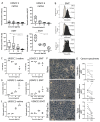Immune-Stimulatory Effects of Curcumin on the Tumor Microenvironment in Head and Neck Squamous Cell Carcinoma
- PMID: 33809574
- PMCID: PMC8001767
- DOI: 10.3390/cancers13061335
Immune-Stimulatory Effects of Curcumin on the Tumor Microenvironment in Head and Neck Squamous Cell Carcinoma
Abstract
Curcumin is known to have immune-modulatory and antitumor effects by interacting with more than 30 different proteins. An important feature of curcumin is the inhibition of nuclear factor kappa of activated B-cells (NF-κB). Here, we evaluate the potential of curcumin to reverse the epithelial to mesenchymal transition (EMT) of head and neck squamous cell carcinoma (HNSCC) cells as a part of tumor escape mechanisms. We examined the impact of curcumin on the expression of different pro- and antitumoral chemokines in ex vivo HNSCC tumor tissue and primary macrophage cultures. Further, we evaluated the combinatorial effect of curcumin and toll-like receptor 3 (TLR3) agonist Poly I:C (PIC) on NF-κB inhibition and regulatory T-cell (Treg) attraction. Mesenchymal markers were significantly reduced in cancer specimens after incubation with curcumin, with simultaneous reduction of key transcription factors of EMT, Snail, and Twist. Furthermore, a decrease of the Treg-attracting chemokine CCL22 was observed. Additionally, curcumin-related inhibition of NF-κB nuclear translocation was evident. The combination of PIC with curcumin resulted in further NF-κB inhibition, whereas PIC alone contrarily resulted in NF-κB activation. Furthermore, curcumin was more effective in inhibiting PIC-dependent NF-κB activation and Treg attraction compared to known NF-κB inhibitors BAY 11-7082 or caffeic acid phenethyl ester (CAPE). The presented results show, for the first time, the immune-modulating effects of curcumin in HNSCC, with potent inhibition of the Treg-attracting effects of PIC. Hence, curcumin presents a promising drug in cancer therapy as a supplement to already established treatments.
Keywords: NF-κB; NF-κB inhibitors; Poly I:C; curcumin; epithelial to mesenchymal transition; head and neck squamous cell carcinoma; modulation of tumor microenvironment.
Conflict of interest statement
The authors declare no conflict of interest. The funders had no role in the design of the study; in the collection, analyses, or interpretation of data; in the writing of the manuscript, or in the decision to publish the results.
Figures






Similar articles
-
Inhibition of growth and survival of human head and neck squamous cell carcinoma cells by curcumin via modulation of nuclear factor-kappaB signaling.Int J Cancer. 2004 Sep 20;111(5):679-92. doi: 10.1002/ijc.20333. Int J Cancer. 2004. PMID: 15252836
-
p53 modulates NF-κB mediated epithelial-to-mesenchymal transition in head and neck squamous cell carcinoma.Oral Oncol. 2015 Oct;51(10):921-8. doi: 10.1016/j.oraloncology.2015.07.006. Epub 2015 Aug 22. Oral Oncol. 2015. PMID: 26306422
-
Evidence that TNF-TNFR1-TRADD-TRAF2-RIP-TAK1-IKK pathway mediates constitutive NF-kappaB activation and proliferation in human head and neck squamous cell carcinoma.Oncogene. 2007 Mar 1;26(10):1385-97. doi: 10.1038/sj.onc.1209945. Epub 2006 Sep 4. Oncogene. 2007. PMID: 16953224
-
The novel role of Yin Yang 1 in the regulation of epithelial to mesenchymal transition in cancer via the dysregulated NF-κB/Snail/YY1/RKIP/PTEN Circuitry.Crit Rev Oncog. 2011;16(3-4):211-26. doi: 10.1615/critrevoncog.v16.i3-4.50. Crit Rev Oncog. 2011. PMID: 22248055 Review.
-
Role of activated nuclear factor-kappaB in the pathogenesis and therapy of squamous cell carcinoma of the head and neck.Head Neck. 2007 Oct;29(10):959-71. doi: 10.1002/hed.20615. Head Neck. 2007. PMID: 17405170 Review.
Cited by
-
Emerging role of RNA sensors in tumor microenvironment and immunotherapy.J Hematol Oncol. 2022 Apr 12;15(1):43. doi: 10.1186/s13045-022-01261-z. J Hematol Oncol. 2022. PMID: 35413927 Free PMC article. Review.
-
Curcuminoids as Anticancer Drugs: Pleiotropic Effects, Potential for Metabolic Reprogramming and Prospects for the Future.Pharmaceutics. 2023 May 29;15(6):1612. doi: 10.3390/pharmaceutics15061612. Pharmaceutics. 2023. PMID: 37376060 Free PMC article. Review.
-
Effects of curcumin on oral cancer at molecular level: A systematic review.Natl J Maxillofac Surg. 2023 Jan-Apr;14(1):9-15. doi: 10.4103/njms.njms_29_22. Epub 2023 Apr 14. Natl J Maxillofac Surg. 2023. PMID: 37273438 Free PMC article. Review.
-
Pharmacological Mechanisms and Clinical Applications of Curcumin: Update.Aging Dis. 2023 Jun 1;14(3):716-749. doi: 10.14336/AD.2022.1101. Aging Dis. 2023. PMID: 37191432 Free PMC article. Review.
-
Regulation of dietary polyphenols on cancer cell pyroptosis and the tumor immune microenvironment.Front Nutr. 2022 Aug 25;9:974896. doi: 10.3389/fnut.2022.974896. eCollection 2022. Front Nutr. 2022. PMID: 36091247 Free PMC article. Review.
References
-
- Stewart B.W., Wild C.P. World Cancer Report 2014. International Agency for Research on Cancer; Lyon, France: 2014. IARC Publications Website-World Cancer Report 2014.
-
- Cooper J.S., Pajak T.F., Forastiere A.A., Jacobs J., Campbell B.H., Saxman S.B., Kish J.A., Kim H.E., Cmelak A.J., Rotman M., et al. Postoperative Concurrent Radiotherapy and Chemotherapy for High-Risk Squamous-Cell Carcinoma of the Head and Neck. N. Engl. J. Med. 2004;350:1937–1944. doi: 10.1056/NEJMoa032646. - DOI - PubMed
-
- Ang K.K., Zhang Q., Rosenthal D.I., Nguyen-Tan P.F., Sherman E.J., Weber R.S., Galvin J.M., Bonner J.A., Harris J., El-Naggar A.K., et al. Randomized Phase III Trial of Concurrent Accelerated Radiation Plus Cisplatin with or Without Cetuximab for Stage III to IV Head and Neck Carcinoma: RTOG 0522. J. Clin. Oncol. 2014;32:2940–2950. doi: 10.1200/JCO.2013.53.5633. - DOI - PMC - PubMed
Grants and funding
LinkOut - more resources
Full Text Sources
Other Literature Sources
Research Materials

